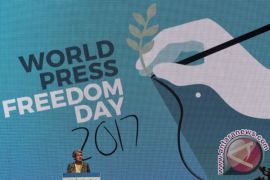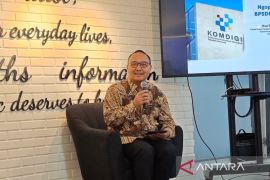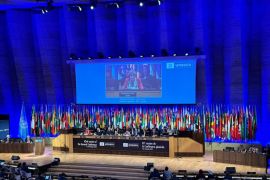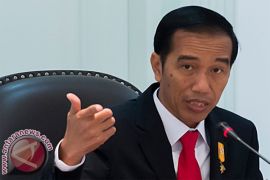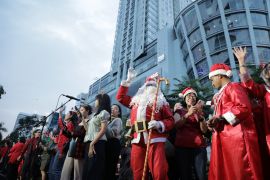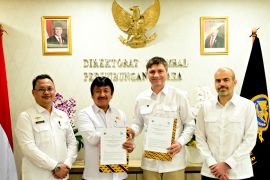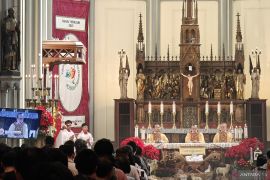Mona Lisa arrested; police officers turning a blind eye to state-owned cars allowed to pass freely during a vehicle inspection; Lady Justice with her balance filled by a heap of gold coins and paper bills adorning her waist, and frightening imagery of a police officer are images featured in Umar’s mural.
To top off the mural, Umar then painted a corpse flower below the Lady Justice’s feet, a warning for the police that even their foul smell would be noticed despite their effort to radiate a positive image if their internal issues and tumultuous relationship with the public were left unaddressed.
“The corpse flower is a symbol that despite their efforts to construct their best image for the public, this could not cover the foul smell of gne problematic issues facing the police institution,” Umar said.
His scathing criticism of the police painted on his mural unexpectedly won the first place, therefore, granting him the Police Chief Cup and a Rp50 million (around US$3,485) cash prize.
The first mural festival
The 2021 Bhayangkara Mural Festival is the first of its kind to be held by the Indonesian Police. The competition was conducted over stages, with competitors vying for a place to enter the next stage until the final stage, which was held at the Police National Headquarters in Jakarta.
From 803 mural designs submitted by participants, around 154 were selected for the next judging stage. The five judges then selected the top 80 murals, with the “criticism of the police” sub-theme slot being filled by ten works.
The festival was earlier planned to have a theme of spreading positive information amidst the COVID-19 pandemic, yet the theme attracted only 18 participants until the third week of the submission period.
The Police Chief’s decision to allow participants to submit works criticizing the police later reenergized the public to participate, causing the number of applicants to jump to 803 at the end of the fourth week of the submission period.
As well as benefiting Indonesian artists and muralists by providing spaces to create new murals, the mural festival is also beneficial to the police, as they could prove that, unlike perceptions of some public members, they are actually open to criticism and respect the right to express an opinion.
“The mural festival removes the walls separating the police and mural artists,” Police’s Public Relations Division Head Police Inspector-General Argo Yuwono said.
An effort to tackle an anti-criticism reputation
The mural depicting President Joko Widodo face superimposed with the words, “404: Not Found,” was discovered in Batuceper, Tangerang, was cited as the precedent to the police’s decision to hold the Bhayangkara Mural Festival.
Upon the mural’s discovery, the Tangerang Police’s statement threatening legal action against the painter caused public uproar, with people accusing it and the government of having an anti-criticism mentality.
Legal threats levied by the police to deter the public instead backfired, as more murals with similar tone and imagery, with slogans such as “Healthy in an ill country” and “the real outbreak is hunger outbreak,” instead appeared. Those murals were later removed by the police.
Understanding the public’s anger over the mural case, the Tangerang Police later backtracked from their earlier statement and decided not to take legal action against the mural’s painter.
Learning from the earlier mural case, Police Chief General Listyo Sigit Prabowo reaffirmed the police recognizes freedom of speech as one of the rights enshrined for the people in the 1945 Constitution and Law No. 9 for 1998 regarding public freedom of expression.
Article 28 of the 1945 Constitution stipulates freedom of speech, expression of opinion, assembly and association are inalienable rights of the people.
Prabowo understood that the current information openness allows everyone to express their opinions, either negative or positive, and also allows everyone to respond to opinions with differing perceptions.
The police chief reiterated the police’s commitment to protecting citizens’ freedom of speech, as Indonesia is a democratic country with rights that must be assured.
“The 2021 Bhayangkara Mural Festival is proof of our commitment to respecting freedom of expression,” Prabowo stated during the festival’s opening ceremony.
He then promised to accept even the most scathing criticism painted in the murals and befriend the artists who point out issues affecting police forces.
As well as highlighting the public’s perceptions of the police force, the mural competition also enbled the police to self-introspect and understand recurring internal issues pointed out by the public, which must be resolved to regain their trust.
A cultured police force
Lecturer of the Indonesia Institute of Arts’ Visual Arts Faculty Dr. Sumbo Tinarbuko said the police’s decision to hold the 2021 Bhayangkara Festival Mural aimed to show the police institution is a cultured institution.
The police must comprehend public communication from a visual arts perspective, he added, noting a symbol or mark, as well as poems or sentences, must not be immediately perceived as threats, as a mural is a symbolic phenomenon that must be interpreted through multiple layers and viewpoints.
Tinarbuko suggested the police must instill a “cultured” value to complement the “humane”value currently promoted as one of its characters.
“As a public observer and columnist, I lauded the Police Chief and regional police chiefs who have instilled a ‘cultured’ value to complement the ‘humane’ value,” he stated.
Police officers must also comprehend public communication and visual semiotics to prevent misinterpretation and over-reaction on a communication medium, particularly in terms of murals, he added.
Editor: Rahmad Nasution
Copyright © ANTARA 2021

